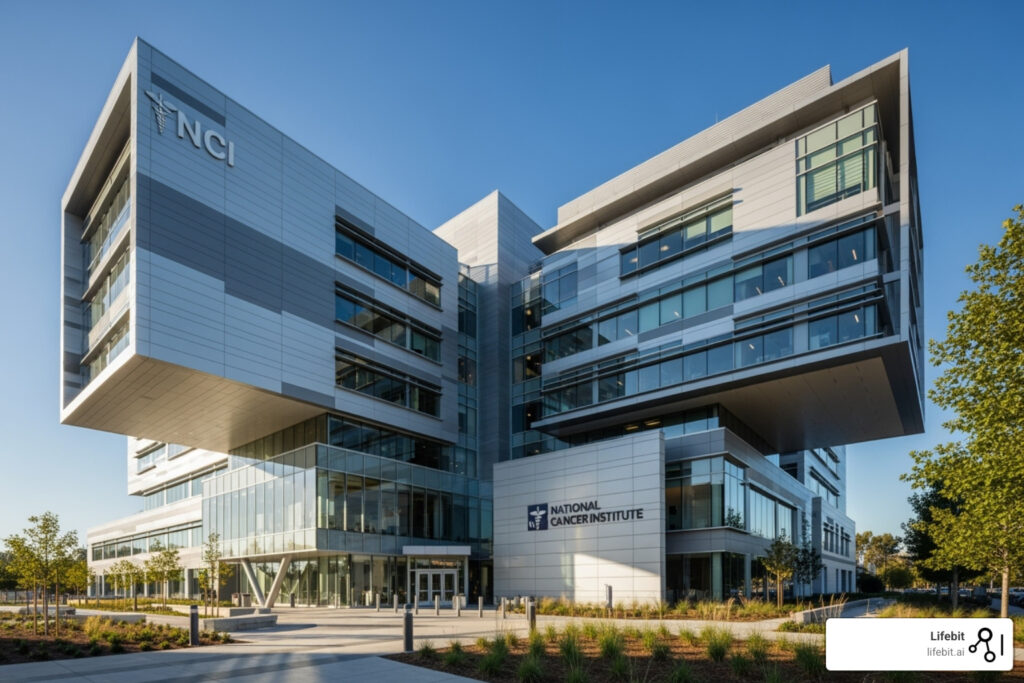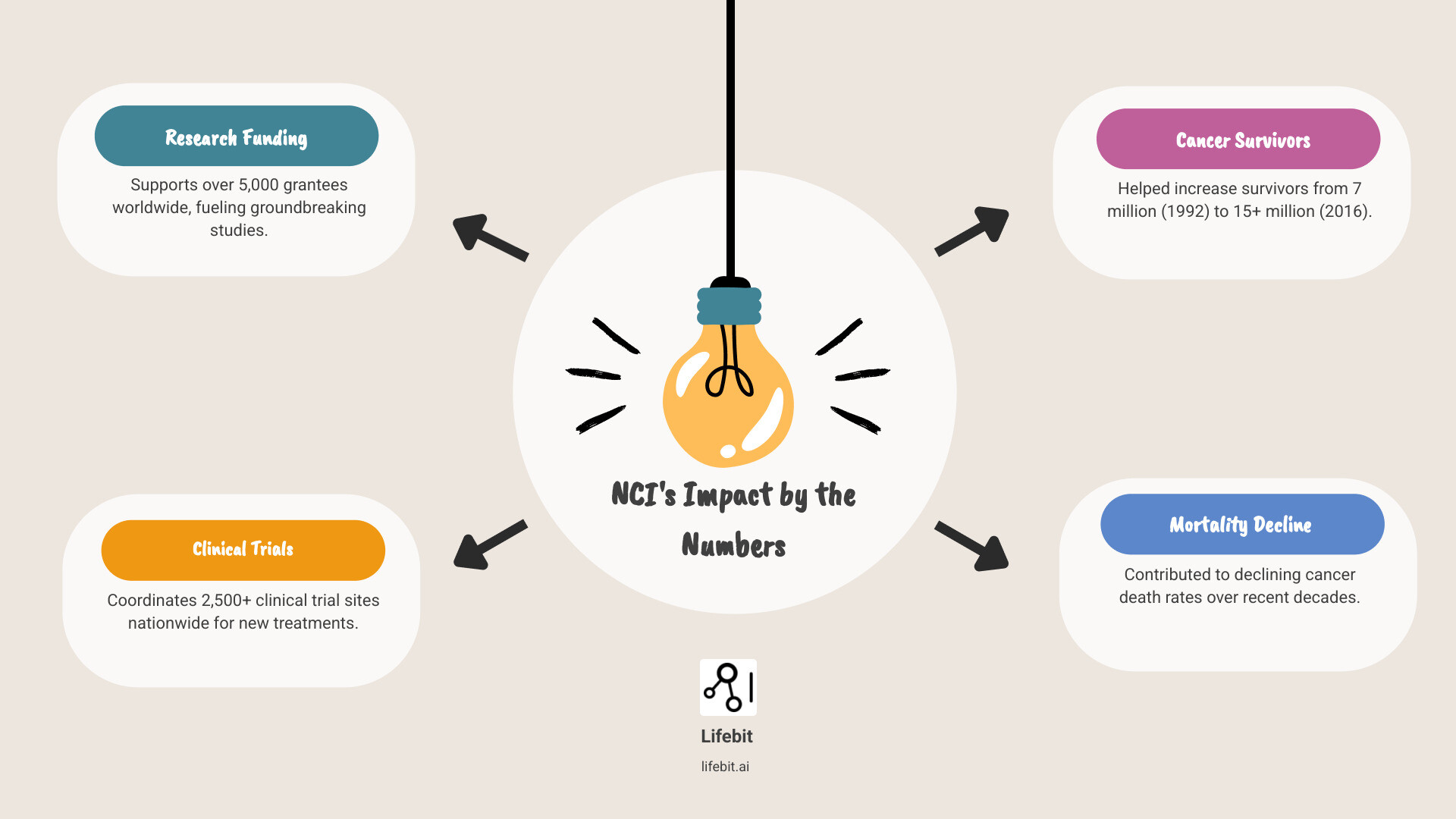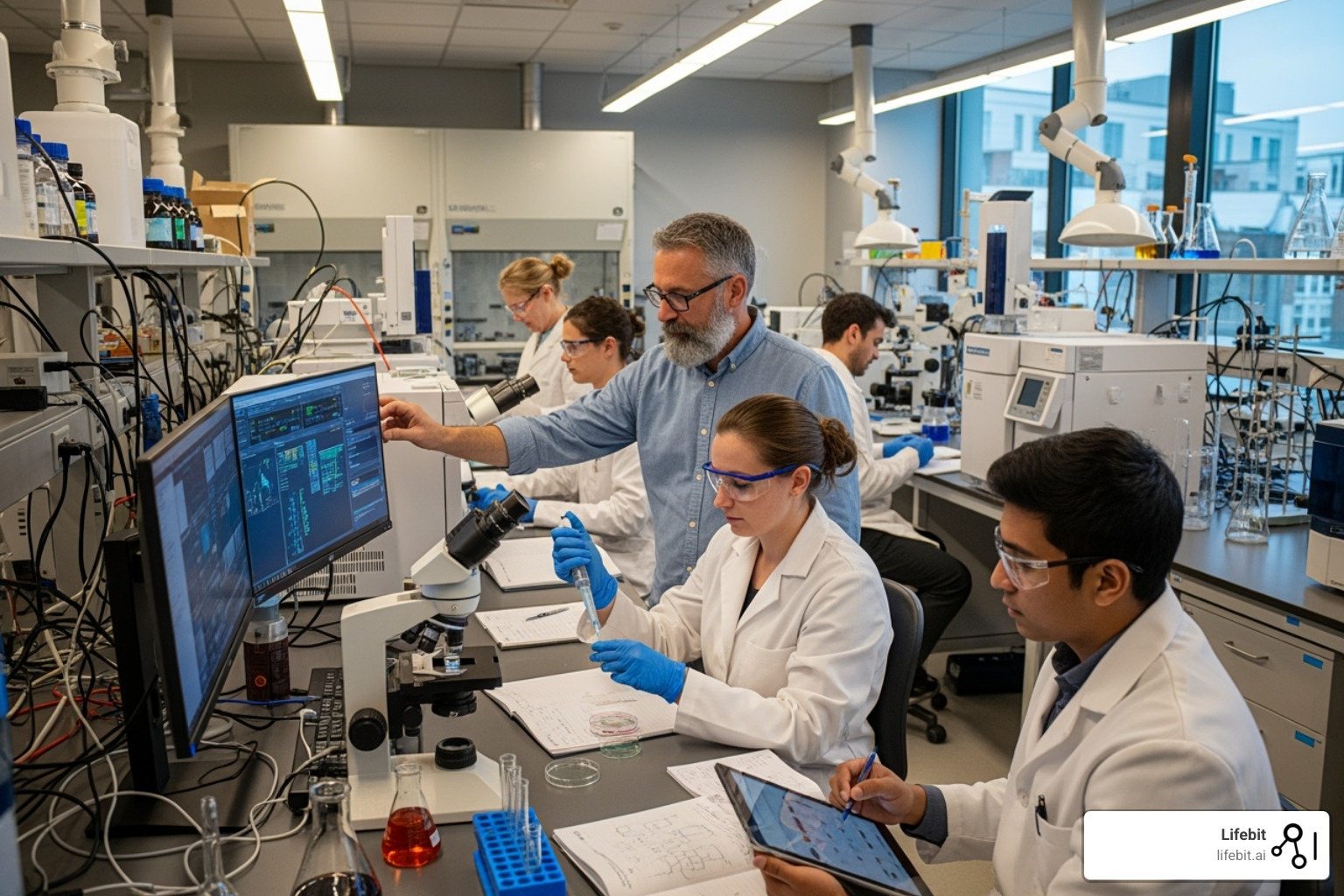Cancer Questions? NCI Has Answers

NCI: Your Essential 2025 Cancer Answers
Why the NCI is Your Gateway to Cancer Research and Information
NCI stands for the National Cancer Institute, the U.S. government’s principal agency for cancer research and the largest funder of cancer research in the world. As part of the National Institutes of Health, the NCI leads, conducts, and supports cancer research across the nation to advance scientific knowledge and help all people live longer, healthier lives.
Quick NCI Overview:
- Primary Role: Federal agency leading cancer research and information
- Part of: National Institutes of Health (NIH)
- Established: 1937 under the National Cancer Act
- Funding: Supports over 5,000 grantees worldwide
- Clinical Trials: Coordinates 2,500+ clinical trial sites nationwide
- Impact: Contributed to declining cancer death rates over recent decades
- Cancer Survivors: Helped increase survivors from 7 million (1992) to 15+ million (2016)
The NCI serves two critical audiences: researchers seeking funding and resources for groundbreaking studies, and patients and families looking for trusted cancer information. Whether you need data on treatment options, want to find clinical trials, or require evidence-based research for regulatory decisions, the NCI provides comprehensive resources backed by decades of scientific expertise.
For pharmaceutical companies, public health agencies, and regulatory bodies working with cancer data, the NCI’s vast research network generates the real-world evidence needed for drug development, safety assessments, and treatment pathway decisions. Their databases contain crucial genomic, clinical, and population health data that powers modern precision medicine approaches.
I’m Maria Chatzou Dunford, CEO and Co-founder of Lifebit, where we help organizations access and analyze biomedical data for drug findy and precision medicine. Through our work with public sector institutions and pharmaceutical companies, I’ve seen how NCI resources and datasets drive breakthrough findies in cancer research and treatment.

Explore more about NCI:
- Cancer Moonshot
- Defense Health Agency
What is the National Cancer Institute (NCI)?

The National Cancer Institute (NCI) is more than just a government agency—it’s the backbone of America’s fight against cancer. As the federal government’s principal agency for cancer research, the NCI has been leading the charge for nearly nine decades, changing how we understand, treat, and prevent cancer.
Think of the NCI as both a research powerhouse and a trusted guide. It operates under the National Institutes of Health (NIH), making it part of the world’s largest public funder of biomedical research. But what makes the NCI special is its dual role: conducting groundbreaking research while also serving as a reliable source of cancer information for patients, families, and healthcare providers.
The Mission and Evolution of the NCI
The NCI‘s official mission is beautifully straightforward: “to lead, conduct, and support cancer research across the nation to advance scientific knowledge and help all people live longer, healthier lives.” This isn’t just corporate speak—it’s a promise that touches millions of lives every year.
The story begins on August 5, 1937, when President Franklin D. Roosevelt signed the National Cancer Act of 1937 into law. This was for its time—the first instance of the federal government dedicating an entire agency to fighting a specific disease. The original NCI was modest compared to today’s operation, but it established something crucial: the authority to award grants to non-federal institutions, creating a network of cancer research that extended far beyond government walls.
The real game-changer came in 1971 with the National Cancer Act of 1971, signed by President Richard Nixon. This legislation transformed the NCI from a research institute into the leader of the National Cancer Program. It authorized the creation of NCI-designated Cancer Centers, strengthened clinical trial networks, and significantly increased funding. Many called it the beginning of the “War on Cancer”—and the NCI became the commanding general.
Today’s NCI is a sophisticated organization with 30 divisions, offices, and centers, each specializing in different aspects of cancer research and patient care. From the molecular biology of cancer cells to population health studies, the NCI covers every angle of the cancer challenge.
Leadership and Future Directions
Strong leadership has always been central to the NCI‘s success. Currently, Dr. W. Kimryn Rathmell serves as the Director, bringing fresh perspectives and expertise to guide the institute’s vast research enterprise. Each director throughout the NCI‘s history has left their mark, pushing the boundaries of what’s possible in cancer research.
The NCI‘s current priorities reflect both exciting scientific opportunities and urgent public health needs. The Cancer Moonshot initiative represents one of the most ambitious efforts to accelerate breakthroughs in cancer prevention, diagnosis, and treatment. This isn’t just about finding new drugs—it’s about fundamentally changing how we approach cancer as a disease.
One particularly concerning trend that’s captured the NCI‘s attention is the rising cancer rates in younger people. This unexpected development is driving new research into environmental factors, lifestyle changes, and genetic predispositions that might explain why cancer is appearing earlier in life than previous generations experienced.
Looking toward the future, the NCI is embracing cutting-edge technologies like artificial intelligence, precision medicine, and advanced genomics. The institute is also doubling down on addressing health disparities, ensuring that breakthrough treatments reach all communities equally. With cancer survivors in the United States growing from 7 million in 1992 to over 15 million today—and projected to exceed 26 million by 2040—the NCI‘s focus on survivorship and long-term health outcomes has never been more important.
For more comprehensive information about the NCI‘s history and mission, visit the official NCI website.
How the NCI Drives Cancer Research and Treatment

The NCI serves as the powerhouse behind virtually every major breakthrough in cancer research and treatment. Think of it as the engine that never stops running, funding findies that transform how we understand and fight cancer.
What makes the NCI so effective is its smart two-pronged approach to research. Intramural research happens right within NCI laboratories, where over 230 basic and clinical research groups work on cutting-edge studies. Extramural research extends the NCI‘s reach by funding thousands of researchers at universities and medical centers worldwide. This strategy ensures no stone is left unturned in the search for answers.
The crown jewel of this research infrastructure is the Frederick National Laboratory for Cancer Research. As the only federally funded research and development center dedicated exclusively to biomedical research, it provides the advanced technologies and innovative platforms that support everything from basic research to clinical studies. It’s where tomorrow’s treatments are born today.
At Lifebit, we see how the foundational research and data infrastructure that the NCI has built over decades continues to power modern breakthroughs in precision medicine and AI-driven drug findy.
Main Research Programs and Breakthroughs
The NCI‘s research spans an impressive range of scientific areas, each contributing unique pieces to the cancer puzzle. Rather than working in silos, these programs create a comprehensive network of knowledge that builds on itself.
The Division of Cancer Biology forms the foundation, supporting basic research that helps us understand how cancer develops and progresses. Managing approximately 2,000 grants each year, this division provides the fundamental knowledge that makes all other advances possible.
Meanwhile, the Division of Cancer Control and Population Sciences acts as the bridge between laboratory findies and real-world impact. This division focuses on reducing cancer’s burden through research in behavioral science, surveillance, and healthcare delivery. The Division of Cancer Prevention takes this a step further, conducting research to determine cancer risk and find ways to reduce it.
When promising research is ready for the next step, the Division of Cancer Treatment and Diagnosis steps in to translate laboratory findings into clinical applications. This division works to speed up the development of new treatments and diagnostic tools that can actually help patients.
The Division of Cancer Epidemiology and Genetics takes a global view, conducting population-based research to find the genetic and environmental factors that cause cancer. The Center for Cancer Genomics, established in 2011, develops and applies genome science to improve diagnosis and treatment through national and international collaborations.
Other specialized programs include the Center for Global Health, which works to reduce cancer worldwide, and the Office of HIV and AIDS Malignancy, focusing on HIV-associated cancers. The Small Business Innovation Research Development Center fosters innovation by involving small businesses in cancer research, while the Office of Cancer Centers supports 72 NCI-designated Cancer Centers nationwide.
These coordinated efforts have led to remarkable breakthroughs. The Cancer Genome Atlas (TCGA) has revolutionized our understanding of cancer at the molecular level, providing invaluable data for personalized medicine. Immunotherapy development has given us treatments that use the body’s own immune system to fight cancer. Targeted therapies now precisely attack cancer cells while minimizing harm to healthy tissue. Genetic testing advancements, powered by vast NCI-supported datasets, are changing how we diagnose and plan treatments.
Recent research shows the NCI‘s continued innovation. Researchers have developed experimental treatments using engineered fat cells that successfully shrink tumors in mice by outcompeting them for nutrients. Another breakthrough involves CAR T-cell therapy targeting the protein GD2, which has shown remarkable success in shrinking aggressive brain and spinal cord tumors in children and young adults, with effects lasting two years or more.
Scientists are even finding that inherited genetic factors predicting cancer risk in the general population can also predict higher risk of new cancers among childhood cancer survivors, opening doors for better prevention strategies.
You can explore more about the Cancer Genome Atlas’s (TCGA) projects to see how genomic research is changing cancer care.
How the NCI Supports Researchers and Clinical Trials
The NCI doesn’t just conduct research – it empowers an entire ecosystem of scientists and clinicians to make findies. By supporting more than 5,000 grantees nationwide, the NCI ensures that brilliant minds across the country have the resources they need to pursue breakthrough research.
But funding is just the beginning. The NCI recognizes that today’s students and postdocs are tomorrow’s cancer research leaders. Through the Center for Cancer Training (CCT), the institute offers comprehensive training programs designed to build a 21st-century workforce. These programs include fellowships that allow researchers to work alongside world-class scientists exploring cancer causes and prevention approaches.
Perhaps nowhere is the NCI‘s impact more visible than in clinical trials. The institute coordinates all phases of clinical trials across an impressive network of 2,500 clinical trial sites nationwide. This isn’t just about numbers – it’s about bringing hope directly to patients and families facing cancer.
The NCI Clinical Trial Network (NCTN) and the NCI Community Oncology Research Program (NCORP) work together to transform how clinical trials are conducted and bring new treatments to patients faster. This vast network serves as the critical bridge between promising laboratory findies and real-world treatments that save lives.
The NCI‘s comprehensive drug development pipeline ensures that potential treatments move efficiently from initial findy through all phases of testing. This systematic approach has contributed significantly to the steady decline in cancer death rates from 2001 through 2022, affecting both men and women across the United States.
These investments in research infrastructure and support have created tangible results that touch millions of lives. The overall decline in new cancer cases and cancer deaths over recent decades reflects the power of sustained, coordinated research efforts.
For more insights into how comprehensive research platforms support cancer findy, you can find more info about NCI and similar research initiatives.
Your Guide to NCI Resources for Patients and the Public

When cancer touches your life—whether through a personal diagnosis or a loved one’s journey—you need information you can trust. The NCI understands this deeply. Beyond its role as a research powerhouse, the institute serves as a compassionate guide for millions of people seeking answers, hope, and practical support.
The NCI has built something remarkable: a bridge between complex scientific research and the everyday needs of patients and families. Through decades of public engagement efforts, they’ve created resources that translate cutting-edge research into understandable, actionable information. This isn’t just about data—it’s about empowering people to make informed decisions during some of life’s most challenging moments.
Finding Answers and Support
Imagine you’ve just received a cancer diagnosis, or your doctor has recommended screening. Where do you turn? The NCI‘s website, cancer.gov, becomes your trusted companion—a place where medical jargon transforms into clear, honest guidance.
The breadth of information available is impressive. You’ll find detailed explanations of cancer types, from the most common like breast and prostate cancer to rare conditions such as childhood esophageal cancer, where changes in esophageal cells create tumors with often unknown causes. Each cancer type page walks you through what you need to know without overwhelming technical details.
Treatment options receive the same thoughtful approach. The NCI explains surgery, chemotherapy, radiation, immunotherapy, and targeted therapies in ways that help you understand what each treatment involves and what questions to ask your medical team. They don’t sugarcoat the realities—you’ll also find comprehensive information about side effects and how to manage both the physical and emotional challenges of treatment.
Recent research has shown that over 90% of people who had their stomach surgically removed to prevent cancer experienced at least one chronic complication two years later. The NCI presents this kind of data not to frighten, but to help people make fully informed decisions alongside their healthcare providers.
Prevention and screening information helps you understand your risk factors and the power of early detection. The institute provides clear guidelines on recommended screening schedules and explains how healthy lifestyle choices can reduce cancer risk. Their resources on diagnosis and staging explain the process of how cancer is identified and classified.
One of the most valuable tools the NCI offers is helping you find clinical trials. These trials represent hope—access to cutting-edge treatments that might not yet be widely available. The NCI‘s search tools help you locate trials by cancer type, location, and treatment approach.
When you need to talk to a real person, the NCI delivers. Their Cancer Information Service connects you with trained specialists through the LiveHelp chat service or by calling 1-800-4-CANCER. These aren’t just call center operators—they’re knowledgeable professionals who understand both the medical and emotional aspects of cancer.
For comprehensive cancer information directly from this trusted source, visit Comprehensive Cancer Information from NCI.
Addressing Cancer Health Disparities
Here’s a hard truth: cancer doesn’t affect everyone equally. Some communities face higher cancer rates, later diagnoses, and worse outcomes. The NCI doesn’t just acknowledge this reality—they’re actively working to change it.
In 2001, the NCI established the Center to Reduce Cancer Health Disparities (CRCHD) with a clear mission: eliminate the unequal burden of cancer in our society. This isn’t just about collecting statistics—it’s about understanding why disparities exist and taking concrete action to address them.
The center focuses on supporting minority researchers, recognizing that diverse perspectives in science lead to better outcomes for everyone. When research teams reflect the communities they serve, they bring cultural understanding and insights that can transform how we approach cancer prevention and treatment.
Community outreach efforts bring cancer education and resources directly to underserved populations. Rather than expecting communities to come to them, CRCHD goes where people are—building trust, sharing culturally appropriate information, and listening to community needs and concerns.
The NCI funds research on diverse populations to uncover the complex factors behind health disparities. This includes studying biological differences, social determinants of health, environmental factors, and systemic barriers to care. For example, researchers are expanding studies on inherited genetic factors that predict cancer risk, ensuring this knowledge benefits childhood cancer survivors from all backgrounds.
The Office of HIV and AIDS Malignancy (OHAM) addresses another critical disparity. People living with HIV face higher risks for certain cancers, and OHAM coordinates research and programs to address these challenges. Their work includes strengthening research capacity for HIV-associated cancers in Africa and managing initiatives like the AIDS Malignancy Consortium.
This commitment to equity isn’t just the right thing to do—it’s essential for advancing cancer research and treatment for everyone. When we understand how cancer affects all populations, we develop better strategies to prevent, detect, and treat it across diverse communities.
Frequently Asked Questions about the NCI
People often reach out to us with questions about accessing the NCI‘s incredible resources. Whether you’re a researcher looking for funding opportunities or a patient seeking reliable information, these are the questions we hear most often.
How do I find an NCI-supported clinical trial?
Finding the right clinical trial can feel overwhelming, but the NCI has made this process much more manageable. Their official website offers a powerful search tool that lets you filter trials by cancer type, geographic location, treatment approach, and other important criteria that matter to your specific situation.
The search functionality is surprisingly intuitive. You can narrow down options based on whether you’re looking for prevention trials, treatment studies, or supportive care research. You can even search by the phase of the trial, which helps you understand how established the treatment being studied is.
However, here’s the most important part: always discuss any potential trial with your healthcare provider before moving forward. Your doctor understands your medical history, current condition, and overall health picture in ways that an online search simply cannot capture. They can help you evaluate whether a particular trial aligns with your treatment goals and determine if you meet the eligibility requirements.
Clinical trials represent partnerships between patients and researchers. They’re designed to advance medical knowledge while providing participants with access to potentially promising treatments that aren’t yet widely available.
Is the information on the NCI website reliable?
This is such an important question, especially in today’s world where medical misinformation spreads quickly online. The answer is a resounding yes – the NCI website is one of the most trustworthy sources of cancer information available.
The NCI operates as the U.S. government’s principal agency for cancer research and serves as a core component of the National Institutes of Health (NIH). Their website, cancer.gov, undergoes rigorous review processes that most other health websites simply don’t match.
Every piece of content is carefully researched by leading experts in their respective fields. The information gets reviewed multiple times before publication, and the NCI regularly updates content to reflect the latest scientific findies and treatment guidelines. This means you’re not just getting accurate information – you’re getting the most current understanding of cancer research and treatment.
When you’re facing a cancer diagnosis or supporting someone who is, having access to reliable information becomes absolutely critical for making informed decisions about care and treatment options.
How does the NCI decide which research to fund?
The NCI‘s funding process is both fascinating and incredibly thorough. They use what’s called a rigorous peer-review process to evaluate every grant application, ensuring that only the most promising and impactful research receives support.
The Division of Extramural Activities (DEA) manages this complex system, which works like this: First, researchers submit detailed proposals explaining their research plans, methodologies, and expected outcomes. These aren’t simple applications – they’re comprehensive documents that can take months to prepare.
Next comes the peer review stage, where panels of independent scientific experts evaluate each proposal. These reviewers assess multiple factors: the scientific merit of the proposed work, whether the research approach is feasible, how innovative the study is, and what kind of impact it might have on cancer prevention, treatment, or understanding.
But the process doesn’t stop there. After peer review, an NCI advisory council provides a second level of evaluation, considering how well each proposal fits with current program priorities and policy directions. Finally, NCI leadership makes funding decisions based on these comprehensive reviews and available budget resources.
This multi-layered approach ensures that the NCI maintains both transparency and fairness in their funding decisions. More importantly, it helps guarantee that research dollars go toward the highest quality science with the greatest potential to improve outcomes for cancer patients.
The entire process reflects the NCI‘s commitment to supporting research that can truly make a difference in the fight against cancer.
Conclusion
The National Cancer Institute (NCI) represents hope, progress, and unwavering dedication in our collective battle against cancer. Since President Franklin D. Roosevelt signed the National Cancer Act in 1937, this remarkable institution has grown into something truly extraordinary – the world’s largest funder of cancer research and a guide of scientific excellence.
What makes the NCI so special is its comprehensive approach. It doesn’t just focus on one piece of the puzzle. Instead, it tackles cancer from every angle: basic science research that open ups the mysteries of how cancer works, clinical trials that bring new treatments to patients, public health initiatives that prevent cancer before it starts, and patient support that helps people steer their cancer journey with reliable, trusted information.
The numbers tell an incredible story of success. The NCI supports over 5,000 grantees worldwide and coordinates more than 2,500 clinical trial sites across the nation. This vast network has contributed to something truly remarkable: significant declines in cancer death rates over the past two decades. Even more inspiring is the dramatic increase in cancer survivors – from 7 million in 1992 to over 15 million in 2016, with projections reaching 26 million by 2040.
These aren’t just statistics. They represent millions of families who have more time together, children who grow up with their grandparents, and communities made stronger by the people cancer didn’t take away.
The NCI‘s scientific breakthroughs have transformed how we understand and treat cancer. Projects like The Cancer Genome Atlas have revolutionized personalized medicine, while advances in immunotherapy and CAR T-cell treatments are giving hope to patients who previously had few options. The institute’s commitment to addressing cancer health disparities ensures that these breakthroughs reach everyone, not just those with the best access to care.
Looking ahead, the NCI faces new challenges with characteristic determination. Rising cancer rates among younger people demand fresh research approaches. Emerging technologies like artificial intelligence offer unprecedented opportunities to accelerate findies. Through initiatives like the Cancer Moonshot, the institute continues pushing boundaries and setting ambitious goals.
At Lifebit, we’re honored to support this vital mission. Our federated AI platform helps researchers and healthcare organizations access and analyze complex biomedical data securely and efficiently. When we see the NCI‘s dedication to scientific excellence and public health, it inspires us to keep innovating and improving how biomedical data powers life-saving findies.
The NCI‘s legacy isn’t just about past achievements – it’s about the future it’s building. Every grant awarded, every clinical trial conducted, and every piece of information shared brings us closer to a world where cancer becomes a manageable condition rather than a devastating diagnosis.

